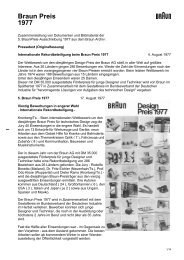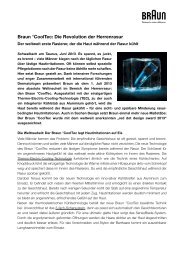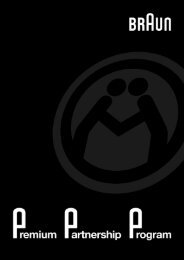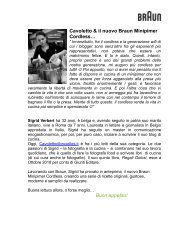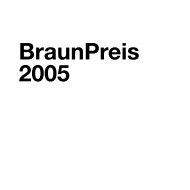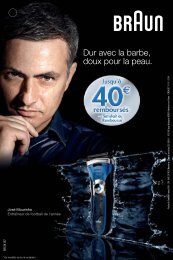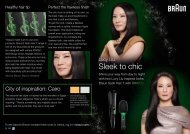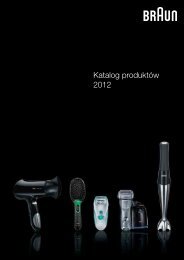BraunPrize 2003
BraunPrize 2003
BraunPrize 2003
Create successful ePaper yourself
Turn your PDF publications into a flip-book with our unique Google optimized e-Paper software.
4 <strong>BraunPrize</strong> Special<br />
The jury and … its work<br />
The <strong>BraunPrize</strong> Jury has always featured leading figures from the<br />
world of design. The traditionally small size of the jury (four members)<br />
makes communication easier and allows the members to focus on<br />
the details, yet still work efficiently. It is also traditional for the head<br />
of Design at Braun to chair the jury: up to 1989 Dr. Fritz Eichler,<br />
up to 1995 Prof. h.c. Dieter Rams, thereafter Peter Schneider.<br />
Anne Stenros, Managing Director of Design<br />
Forum Finland, studied architecture in<br />
Finland and California. In 1992, she received<br />
her doctorate from the Helsinki University<br />
of Technology. She has been Managing<br />
Director of Design Forum Finland since 1995<br />
and is Editor-in-chief of the magazine<br />
“Form Function Finland” and the yearbook<br />
“Design in Finland”.<br />
Alexander Manu, Principal of Axis Group<br />
International in Toronto, studied industrial<br />
design at the Institute for Fine Arts in<br />
Bucharest and was elected to the Royal<br />
Canadian Academy of Arts (RCA). He esta-<br />
blished Axis Group International in Toronto<br />
in 1980 and works as a designer and author<br />
as well as teaching at the Ontario College<br />
of Art and Design.<br />
Left to right: Rainer Silbernagel, Anne Stenros, Peter Schneider, Alexander Manu<br />
Rainer Silbernagel, Director New Product<br />
Engineering at Braun, studied micro-<br />
technology, technical optics and medical<br />
technology at Frankfurt am Main University<br />
of Applied Sciences. He joined the Product<br />
and Industrial Engineering function at<br />
Braun in 1988 and has been in charge of it<br />
since 1995.<br />
Peter Schneider, Director Corporate Design<br />
at Braun, studied industrial design at the<br />
Folkwangschule in Essen. One of the winners<br />
of the <strong>BraunPrize</strong> in 1972, he has worked<br />
in the Design Department at Braun since<br />
1973 and took over as its head in 1995.<br />
He has been chairman of the jury and<br />
responsible for the <strong>BraunPrize</strong> since 1999.<br />
The <strong>2003</strong> <strong>BraunPrize</strong> attracted 558 entries<br />
from 52 countries – a new record! For<br />
the first time, the entry documents could be<br />
submitted by uploading directly to the<br />
<strong>BraunPrize</strong> server. The fact that only 42% of<br />
the entries were submitted by traditional<br />
mail shows how much easier the electronic<br />
entry facility makes it for entrants from all<br />
over the world to participate.<br />
1st jury session, German Design Council, Frankfurt 2nd jury session, Civic Hall, Kronberg<br />
At the first jury session, which took place<br />
from April 1 – 3, <strong>2003</strong> at the German Design<br />
Council in Frankfurt, the entries (which<br />
could be identified only by means of an<br />
anonymous number) were assessed on the<br />
basis of project descriptions, design<br />
sketches, technical drawings and photos.<br />
The jury selected 58 entries from 21<br />
countries to go through to the second round.<br />
At the second jury session, which took<br />
place in Kronberg from June 2 – 4, <strong>2003</strong>,<br />
the assessment was based on the design<br />
models. After an in-depth exploration<br />
of the concepts and the way they had been<br />
implemented, the jury nominated the<br />
four best entries for the final round at the<br />
<strong>BraunPrize</strong> Forum as well as 18 other<br />
projects for the <strong>BraunPrize</strong> Exhibition.<br />
Assessment criteria<br />
• Design, innovation, aesthetics, clarity, usability<br />
• Technology – how convincing is the product functionality?<br />
• Usability – the benefit which the product provides for the user<br />
Additional aspects<br />
• The clarity of the content<br />
• The quality of the presentation and the design models<br />
• A thorough analysis of conditions and needs<br />
• The feasibility of the concept with regard to processes and costs<br />
• The social acceptance of the product idea<br />
• The environmental compatibility of the product concept



